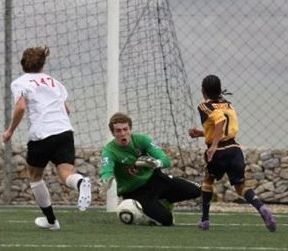Defense
Most teams play a formation with four defenders: two central defenders and two outside defenders or fullbacks.Central Defenders
The center back, or stopper, is positioned in the center of the defense, and is responsible for stopping opposing players, especially forwards, from scoring, and for kicking the ball out of their team's penalty area. There are usually two central defenders positioned in front of the goalkeeper. Stoppers play either zone or man to man defense.Sweeper
In some formations, a single defender will play closest to goal behind the other defenders as a last line of defense in front of the goalkeeper. He or she is called the sweeper because it his/her job to "sweep" the ball away when it gets behind the last defender.Outside Defenders/Fullbacks
Fullbacks play the two outside positions in a four man defensive backfield and are responsible for guarding or "marking" offensive players attacking from the wings. Their job is keep players from cutting inside to attack the goal and for cutting off passes or "crosses" by wing players feeding strikers in the penalty area for shots on goal.Wing back
Wingbacks are fullbacks that also go on the offensive on the wings, meaning they are likely to run more than any other player.
Goalkeeper (a/k/a goalie or keeper)
Goalkeepers are the only players allowed to touch the ball with their hands or arms. Even then, are two circumstances in which even the goalie may not touch the ball with his or her hands: 1) when the ball comes to the goalie via a pass off a teammate's foot (as opposed to being chested or headed back to the goalie), and 2) when the ball is outside the 18-yard box (penalty area). Each team must have a goalkeeper on the field at all times (which means that, if the goalie is injured and the team is unable to replace him with a goalie on the bench, one of the players already on the field must become the goalie).








